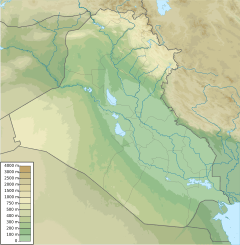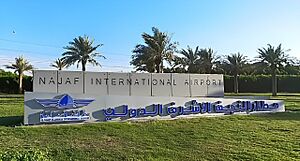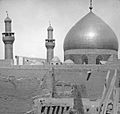Najaf facts for kids
Quick facts for kids
Najaf
ٱلنَّجَف
an-Najaf al-Ashraf, Baniqia
|
|
|---|---|
|
Imam Ali Shrine in Najaf, among the holiest sites for Shia Muslims
|
|
| Nickname(s):
al-Ashraf
|
|
| Country | |
| Governorate | Najaf |
| Founded by | Hārūn al-Rashīd |
| Government | |
| • Type | Mayor–council |
| Elevation | 60 m (200 ft) |
| Population | |
| • Estimate
(2018)
|
747,261 |
| • Rank | 10th |
| • Metro | 988,000 |
| Time zone | UTC+3 |
Najaf (pronounced Nah-jaf), also known as An-Najaf or Al-Najaf (Arabic: ٱلنَّجَف), is a major city in central Iraq. It is located about 160 kilometers (99 miles) south of Baghdad, the capital of Iraq. In 2024, its population was estimated to be around 1.41 million people.
Najaf is considered one of the holiest cities for Shia Islam and is a very important spiritual center. It is also a key place for Shia political power in Iraq. The city is famous as the burial place of ‘Alī ibn Abī Tālib, who was a cousin and son-in-law of the Islamic prophet Muhammad. Because of this, many Shia Muslims visit Najaf on pilgrimage. The city is also home to the world's largest cemetery, Wadi-us-Salaam, and the oldest Shia Islamic school, called the Hawza of Najaf.
Contents
- What's in a Name? The Meaning of Najaf
- A Look Back: The History of Najaf
- Where is Najaf? Its Geography and Climate
- Why Najaf is Important: Religious Significance
- Najaf's Economy: A City of Pilgrims and Progress
- Culture and Sports in Najaf
- Learning and Education in Najaf
- Modern Infrastructure and Travel
- International Connections
- Images for kids
- See also
What's in a Name? The Meaning of Najaf
The word "najaf" (نجف) means a high, rectangular area where water collects but doesn't overflow. Another idea is that "Najaf" comes from "nay jaff," which means "the nay sea has dried." This name might have changed over time to "Najaf."
Najaf is often called "al-Ashraf," meaning "the dignified." This is because ‘Alī ibn Abī Tālib, a very respected person, is buried there. The city has other historical names too, like Al-Ghari, Baniqiya, and Wadi l-Salam.
A Look Back: The History of Najaf
Najaf is located near ancient cities like Babylon and Ur. The city itself was officially founded in 791 AD by the Abbasid ruler Harun al-Rashid. He ordered a shrine to be built for ‘Alī bin Abī Ṭālib.
Early Days and Ancient Discoveries
Archaeologists have found signs that people lived in the Najaf area as far back as the 1st century BC. It was a place where different cultures and religions lived together. For example, Najaf has one of the largest Christian cemeteries in Iraq. Crosses and carvings of Christ have been found on graves there. There is also evidence of a glass industry and Hebrew writings, showing a mix of communities.
The Wadi-us-Salaam cemetery in Najaf was also a holy burial ground for Jewish people. At that time, Najaf was sometimes called Baniqia. It is said that Abraham visited this village during his journey long ago.
How Najaf Became a Holy City
In Islamic tradition, the city's importance began with Ali. He wanted his burial place to be a secret because he had enemies. Legend says his body was placed on a camel, which stopped a few miles west of Kufa. There, Ali was secretly buried.
More than a hundred years later, the Abbasid ruler Harun al-Rashid was hunting deer. The deer found safety in a certain spot where his hunting dogs would not follow. When he asked why, he was told it was Ali's burial place. Harun al-Rashid then ordered a building to be built there. Over time, the city of Najaf grew around this important shrine.
Najaf Through the Centuries
In the 14th century, a famous traveler named Ibn Battuta visited Najaf. He described it as a beautiful and busy place, known for its miracles. People believed that if they made a promise there, they would get better from illnesses.
In the 16th century, the Ottoman Empire took control of Najaf. The Safavid dynasty from Iran also showed interest in this Shia holy site. They captured the city twice but lost it back to the Ottomans.
Najaf faced tough times under Ottoman rule. There were attacks from desert tribes and the Persian army. The city also had severe water shortages. The number of homes dropped from 3,000 to just 30 by the early 16th century. The Euphrates river changed its path, leaving Najaf without a good water supply.
Things improved in 1803 when the Euphrates river returned to the city. This helped Najaf grow again. The city's religious leaders gained more power. In 1811, the city walls were rebuilt.
Modern Times and Changes
The Ottomans were removed from power in 1915, and the British Empire took over. In 1918, the leaders of Najaf rebelled against the British. The British then surrounded the city and cut off its water. The rebellion was stopped, and many Shia scholars were sent away to Persia. This led to the city of Qom in Iran becoming a major center for Shia learning. Najaf did not regain its top religious spot until the 21st century.
In the 20th century, parts of the Old City were rebuilt. Many old buildings were taken down to make way for new streets. In 1958, the city wall was removed and replaced with a ring road.
Najaf After 2003
During the 2003 U.S. invasion of Iraq, Najaf was an important target. There was heavy fighting, and the city was captured by U.S. forces. In April 2004, a group called the Mahdi Army attacked a military base in Najaf. This led to more fighting between U.S. forces and the Mahdi Army in August 2004. The fighting ended when a senior Iraqi religious leader, Grand Ayatollah Ali al-Sistani, helped make a peace agreement.
In 2012, Najaf was chosen as the Cultural Centre of the Arab World. In 2021, Pope Francis visited the city. He met with al-Sistani to talk about peace between Muslims and Christians in Iraq.
Where is Najaf? Its Geography and Climate
Najaf is located in central Iraq. It has a hot desert climate. This means it has very long, hot summers and mild winters. The average yearly temperature is about 23.6 degrees Celsius (74.5 degrees Fahrenheit). The city gets about 69 millimeters (2.71 inches) of rain each year.
| Climate data for Najaf (1991–2020) | |||||||||||||
|---|---|---|---|---|---|---|---|---|---|---|---|---|---|
| Month | Jan | Feb | Mar | Apr | May | Jun | Jul | Aug | Sep | Oct | Nov | Dec | Year |
| Record high °C (°F) | 26.0 (78.8) |
32.5 (90.5) |
41.7 (107.1) |
43.0 (109.4) |
48.3 (118.9) |
51.4 (124.5) |
51.5 (124.7) |
51.0 (123.8) |
49.2 (120.6) |
43.7 (110.7) |
34.5 (94.1) |
29.4 (84.9) |
51.5 (124.7) |
| Mean daily maximum °C (°F) | 17.1 (62.8) |
20.2 (68.4) |
25.6 (78.1) |
31.6 (88.9) |
38.5 (101.3) |
43.2 (109.8) |
45.4 (113.7) |
45.2 (113.4) |
41.4 (106.5) |
34.8 (94.6) |
24.6 (76.3) |
18.7 (65.7) |
32.2 (90.0) |
| Daily mean °C (°F) | 11.2 (52.2) |
14.0 (57.2) |
18.8 (65.8) |
24.9 (76.8) |
31.3 (88.3) |
35.8 (96.4) |
38.1 (100.6) |
37.6 (99.7) |
33.4 (92.1) |
28.5 (83.3) |
18.0 (64.4) |
12.8 (55.0) |
25.4 (77.7) |
| Mean daily minimum °C (°F) | 6.3 (43.3) |
8.3 (46.9) |
12.6 (54.7) |
18.2 (64.8) |
23.9 (75.0) |
27.7 (81.9) |
29.9 (85.8) |
29.4 (84.9) |
25.8 (78.4) |
20.4 (68.7) |
12.6 (54.7) |
7.8 (46.0) |
18.6 (65.5) |
| Record low °C (°F) | −7.2 (19.0) |
−4.5 (23.9) |
2.2 (36.0) |
7.0 (44.6) |
13.0 (55.4) |
17.0 (62.6) |
19.4 (66.9) |
22.2 (72.0) |
18.3 (64.9) |
7.0 (44.6) |
0.2 (32.4) |
−2.5 (27.5) |
−7.2 (19.0) |
| Average precipitation mm (inches) | 16.4 (0.65) |
10.7 (0.42) |
9.1 (0.36) |
14.4 (0.57) |
3.4 (0.13) |
0.0 (0.0) |
0.0 (0.0) |
0.0 (0.0) |
0.0 (0.0) |
6.3 (0.25) |
19.6 (0.77) |
12.9 (0.51) |
92.8 (3.65) |
| Average relative humidity (%) | 67.0 | 57.6 | 47.4 | 41.1 | 31.4 | 24.5 | 22.6 | 23.7 | 28.8 | 39.9 | 56.5 | 65.3 | 42.2 |
| Source: NOAA, Meteomanz(record high since 2009) | |||||||||||||
Why Najaf is Important: Religious Significance
An-Najaf is very important to Shia Muslims. It is famous as the burial place of ‘Alī ibn Abī Tālib, who was a very important figure in early Islam. Many Shia Muslims from all over the world visit Najaf. It is believed that only Mecca and Medina receive more Muslim visitors.
The Imam Ali Mosque
The Imam Ali Mosque is a grand building with a golden dome. It holds many valuable items. Shia Muslims consider it the third holiest Islamic site.
Wadi-us-Salaam Cemetery
Near the mosque is the Wadi-us-Salaam cemetery. It is the largest cemetery in the world. Many devout Muslims wish to be buried there. They believe they will rise with Imam Ali on Judgement Day. Over hundreds of years, many schools, libraries, and places for visitors were built around the shrine. This made Najaf a major center for Shia learning and religious studies.
The Najaf Seminary
The An-Najaf seminary, also called the Hawza Najaf, is one of the most important teaching centers in the Islamic world. It is the oldest hawza (Shia Islamic school) in the world. It was started by a famous scholar named Shaykh Tusi. Many important religious leaders, like Ayatollah Khomeini, studied and taught there. Today, it has thousands of students.
Najaf's Economy: A City of Pilgrims and Progress
After the Ba'athist government fell, more Shia Muslims could visit Najaf. This led to a big increase in pilgrims and a greater need for hotels and other facilities. In 2006, the government started a project to rebuild the western part of the city for pilgrims.
Najaf, along with Karbala, is a busy place for Shia Muslim pilgrims. The pilgrimage business grew a lot after Saddam Hussein's rule ended. However, U.S. sanctions on Iran have caused fewer Iranian pilgrims to visit.
Since the end of the 2003–2011 war, many new projects have been planned for Najaf. The city is seen as a good example for development in Iraq. Najaf has been growing economically. In 2008, over half of the 200 approved investment projects, worth $8 billion, were being built in Najaf Governorate. Most of these projects were for housing and tourism. Najaf is known as a "stable investment environment" and has seen more investments. A Saudi Arabian company is building a large solar power plant in Najaf.
The government also plans to build 15 housing complexes in Najaf, costing $7 billion. This is part of 240 projects. Two industrial parks are also being developed. In 2024, the prime minister, Mohammed Shia' Al Sudani, announced more projects for the city. These include a carpet-washing factory for the Holy shrine and new factories for cement bags and glass. The glass factory is expected to be very profitable because the Najaf desert has high-quality raw materials for it.
Culture and Sports in Najaf
Religious Tourism
Najaf is home to the Sanctuary of Imam Ali. This makes it a destination for many Shia religious pilgrims from around the world every year.
Sports Teams and Stadiums
The city of Najaf has two football clubs: Al-Najaf SC and Naft Al-Wasat SC. Al-Najaf SC plays in the top league, the Iraq Stars League. Naft Al-Wasat SC plays in the second-tier Iraqi Premier Division League.
Najaf has two football stadiums. The older An-Najaf Stadium can hold 12,000 people. The newer Al-Najaf International Stadium can hold 30,000 people. The new stadium is the home ground for Al-Najaf and Naft Al-Wasat. The old stadium is used by the nearby Al-Kufa SC.
Najaf's Influence on Other Cultures
The Iranian city of Najafabad was named by Shah Abbas I in honor of Najaf. Legend says that Shah Abbas wanted to send a gift to the Shrine of Imam Ali. But the caravan carrying the gift stopped near Isfahan, Iran, and would not move. A scholar told the Shah that Imam Ali had appeared to him in a dream. Ali wanted the gift to be used to develop the area where the caravan stopped. The Shah agreed, and the city grew. It became known as "Najaf Abad," which means "City of Najaf" in Persian.
Learning and Education in Najaf
Universities in Najaf
Najaf is home to several universities, including:
- Al-Furat Al-Awsat Technical University
- Islamic University College
- University of Alkafeel
- Jabir Ibn Hayyan Medical University
- Altoosi University College
The Najaf Seminary: A Center for Islamic Study
The Najaf Seminary in Iraq and the Qom Seminary in Iran are the two main centers for traditional Shia Islamic education. They have their own ways of teaching and different study plans. The Najaf Seminary is the oldest hawza in the world. It was founded by a famous Shia scholar named Shaykh Tusi.
Many important scholars have studied at the Najaf Seminary. These include Murtadha al-Ansari, Muhammad Kazim Khurasani, Mohammed Kazem Yazdi, Abbas Qomi, Abu al-Qasim al-Khoei, and Ali al-Sistani.
Modern Infrastructure and Travel
Najaf International Airport is a very important travel hub. It helps with transportation, especially for religious tourism. Each year, over 3 million passengers use the airport. Most of them are pilgrims visiting Najaf's holy sites. The airport is located about 6 kilometers (3.7 miles) east of the city center.
In February 2024, Iraq announced plans to build a high-speed rail line. This train will connect Najaf and Karbala. Once finished, it will be able to carry up to 25,000 passengers every hour. A new road connecting Iraq and Saudi Arabia near Najaf is also almost complete.
International Connections
Sister Cities
As of 2024, Najaf has three sister cities:
 Minneapolis, United States
Minneapolis, United States Najafabad, Iran
Najafabad, Iran Mashhad, Iran
Mashhad, Iran
Images for kids
See also
 In Spanish: Náyaf para niños
In Spanish: Náyaf para niños













